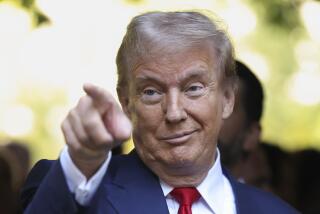After Trump’s new round of tariffs, China may either have to blink or widen the trade war
DANDONG, China — President Trump’s latest round of tariffs against China, totaling approximately $200 billion, substantially raises the stakes for Beijing and could push the two countries’ trade war into a new phase, beyond the tit-for-tat duties seen so far.
China’s Commerce Ministry said Wednesday that China would act with “necessary counter-measures,” but did not repeat that the government would retaliate in commensurate fashion, as it has promptly done in the past. The pause in brinkmanship reflects the quandary now facing Beijing.
The new U.S. proposed levies would be on top of 25% tariffs that the Trump administration has assessed on $50 billion of Chinese goods, $34 billion of which took effect last Friday. On that day China fired back with tariffs of the same amount.
But Beijing cannot match the new proposed tariffs because China imported only about $130 billion of products from the U.S. last year. By comparison, the United States imported more than $500 billion of Chinese goods last year.
Lu Xiang, a Beijing-based researcher at the Chinese Academy of Social Sciences, noted that China has previously indicated that it would retaliate in “quality and quantity,” suggesting that Beijing could employ a wide range of measures — beyond tariffs — that would hurt American businesses in China, such as tougher inspections on imports and delaying licensing and approvals for mergers.
“Chinese counter-measures are more than tariffs; it is hard to guess” what they are, Lu said. He added: “China has prepared for the worst.”
Tuesday’s proposed tariffs would assess a smaller 10% tax on $200 billion of Chinese goods, but unlike the previous tranche of levies, these include many familiar household products such as electronics, appliances, furniture, some apparel and footwear. That sparked immediate fire from the National Retail Federation, which called the latest Trump administration plan “a reckless strategy that will boomerang back to harm U.S. families and workers.”
Beijing may be holding off from retaliating in equal measure to see if the latest tariffs, which would affect more consumer goods, will prompt a strong enough pushback from interest groups to persuade Trump to pull back from his aggressive trade actions against China.
Trump already has imposed levies on Chinese solar panels, steel, aluminum and many machine and industrial parts. They are aimed at pressuring China to make significant changes that would sharply reduce its trade surplus with the U.S. Others in the administration want to press China to halt policies that compel American firms to turn over technologies in order to obtain access to the large Chinese market.
Up to now, however, growing complaints about Trump’s broad tariffs from U.S. businesses, associations, lawmakers and even politically powerful constituents such as farmers have not dissuaded the president from following through on his threats.
Trump has promised to impose tariffs on all Chinese imports if Beijing keeps fighting back and does not accede to his demands — something he promised on the campaign trail.
Beijing expressed “shock” at Tuesday’s announcement from the White House, but UBS economist Tao Wang said China is increasingly concerned about how far the trade war might go.
“The Chinese government understands that a full-scale trade war does more economic harm to China,” she said.
Chinese leaders also may be hoping that global financial markets will send Trump clear signals that will force the president’s hand.
But nervous and uneasy as they may be, investors have been unexpectedly restrained in their reaction, thanks in part to strong U.S. economic growth aided by big tax cuts earlier this year.
Chinese and other Asian stocks retreated Wednesday, and U.S. stocks were down sharply at the open after the White House unveiled the new tariffs. Even so, the Dow Jones industrial average, through Tuesday’s close, was essentially unchanged from the start of the year.
One strategy that Beijing wants to undertake to fight back is to enlist the support of other countries, particularly Western allies of the U.S., against what Chinese officials say are Trump’s unilateral protectionist moves that threaten not just American and Chinese economies but the entire world, as well as the global trading system.
“We call on the international community to work together to safeguard the rules of free trade and the multilateral trading system, and jointly oppose trade hegemony,” China’s Commerce Ministry said Wednesday. A spokesman for the ministry said China would file another formal complaint with the World Trade Organization.
The European Union and Canada, America’s closest allies, also have struggled with Trump’s trade policies. The EU, Canada, Mexico and Japan, among others, protested after the White House slapped tariffs on steel imports from those trading partners.
EU and other analysts doubt that America’s allies will line up behind Beijing, given their historically close military relations with the U.S. and the fact that many of those countries also have complained about China’s unfair trade practices and policies.
Some experts think that China and the U.S. will soon find it in their mutual interest to return to the negotiating table and resolve the intensifying trade conflict.
“While there is currently frighteningly little bilateral discussion taking place, increased domestic opposition in the U.S. to tariffs would make such talks more likely,” Oxford Economics said in a research note.
But “in the absence of such discussions,” the note said, “the U.S. and China seem set for a more full-blown trade war, with major economic implications for themselves and the global economy.
More to Read
Sign up for Essential California
The most important California stories and recommendations in your inbox every morning.
You may occasionally receive promotional content from the Los Angeles Times.











